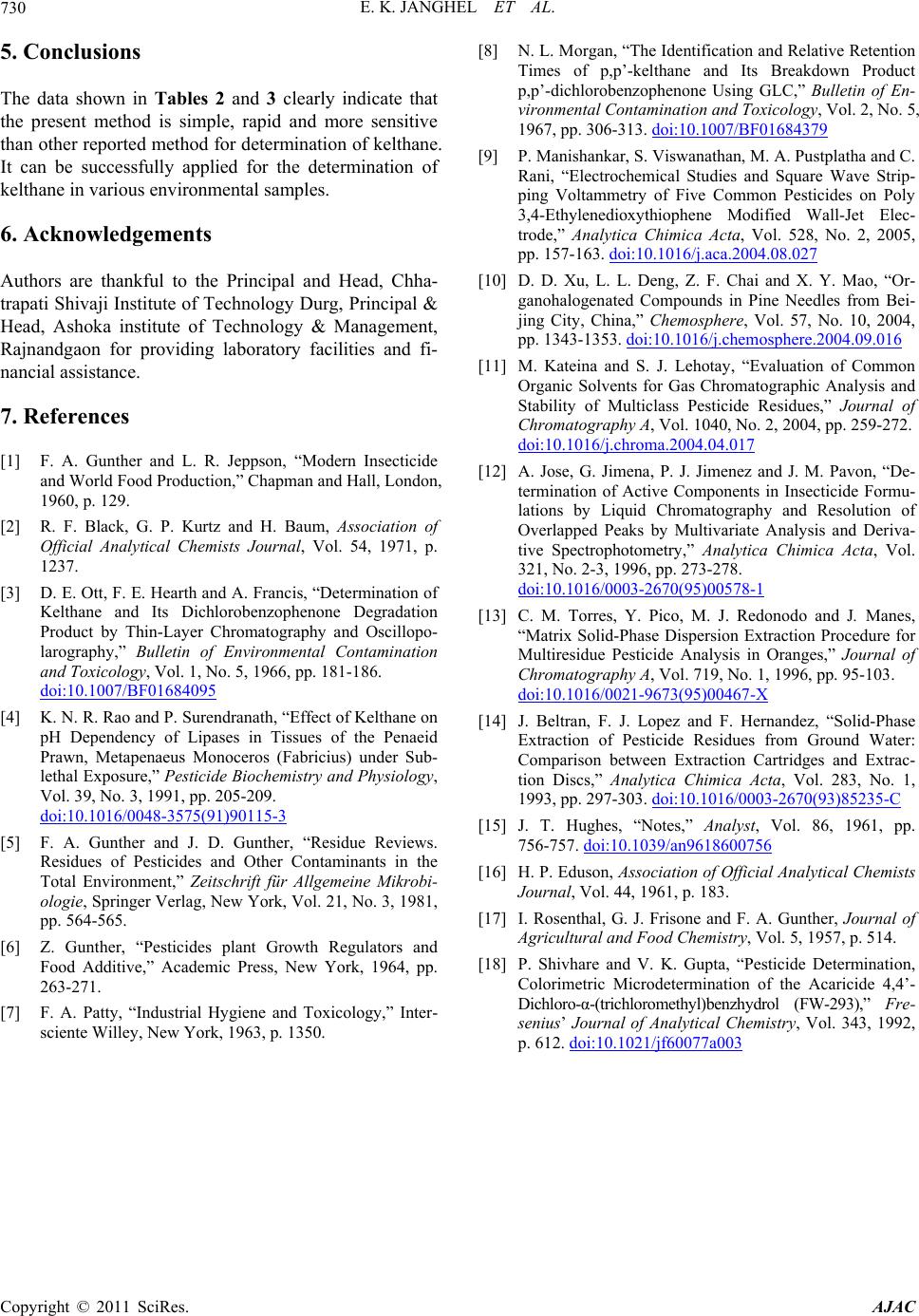
E. K. JANGHEL ET AL.
Copyright © 2011 SciRes. AJAC
730
5. Conclusions
The data shown in Tables 2 and 3 clearly indicate that
the present method is simple, rapid and more sensitive
than other reported method for determination of kelthane.
It can be successfully applied for the determination of
kelthane in various environmental samples.
6. Acknowledgements
Authors are thankful to the Principal and Head, Chha-
trapati Shivaji Institute of Technology Durg, Principal &
Head, Ashoka institute of Technology & Management,
Rajnandgaon for providing laboratory facilities and fi-
nancial assistance.
7. References
[1] F. A. Gunther and L. R. Jeppson, “Modern Insecticide
and World Food Production,” Chapman and Hall, London,
1960, p. 129.
[2] R. F. Black, G. P. Kurtz and H. Baum, Association of
Official Analytical Chemists Journal, Vol. 54, 1971, p.
1237.
[3] D. E. Ott, F. E. Hearth and A. Francis, “Determination of
Kelthane and Its Dichlorobenzophenone Degradation
Product by Thin-Layer Chromatography and Oscillopo-
larography,” Bulletin of Environmental Contamination
and Toxicology, Vol. 1, No. 5, 1966, pp. 181-186.
doi:10.1007/BF01684095
[4] K. N. R. Rao and P. Surendranath, “Effect of Kelthane on
pH Dependency of Lipases in Tissues of the Penaeid
Prawn, Metapenaeus Monoceros (Fabricius) under Sub-
lethal Exposure,” Pesticide Biochemistry and Physiology,
Vol. 39, No. 3, 1991, pp. 205-209.
doi:10.1016/0048-3575(91)90115-3
[5] F. A. Gunther and J. D. Gunther, “Residue Reviews.
Residues of Pesticides and Other Contaminants in the
Total Environment,” Zeitschrift für Allgemeine Mikrobi-
ologie, Springer Verlag, New York, Vol. 21, No. 3, 1981,
pp. 564-565.
[6] Z. Gunther, “Pesticides plant Growth Regulators and
Food Additive,” Academic Press, New York, 1964, pp.
263-271.
[7] F. A. Patty, “Industrial Hygiene and Toxicology,” Inter-
sciente Willey, New York, 1963, p. 1350.
[8] N. L. Morgan, “The Identification and Relative Retention
Times of p,p’-kelthane and Its Breakdown Product
p,p’-dichlorobenzophenone Using GLC,” Bulletin of En-
vironmental Contamination and Toxicology, Vol. 2, No. 5,
1967, pp. 306-313. doi:10.1007/BF01684379
[9] P. Manishankar, S. Viswanathan, M. A. Pustplatha and C.
Rani, “Electrochemical Studies and Square Wave Strip-
ping Voltammetry of Five Common Pesticides on Poly
3,4-Ethylenedioxythiophene Modified Wall-Jet Elec-
trode,” Analytica Chimica Acta, Vol. 528, No. 2, 2005,
pp. 157-163. doi:10.1016/j.aca.2004.08.027
[10] D. D. Xu, L. L. Deng, Z. F. Chai and X. Y. Mao, “Or-
ganohalogenated Compounds in Pine Needles from Bei-
jing City, China,” Chemosphere, Vol. 57, No. 10, 2004,
pp. 1343-1353. doi:10.1016/j.chemosphere.2004.09.016
[11] M. Kateina and S. J. Lehotay, “Evaluation of Common
Organic Solvents for Gas Chromatographic Analysis and
Stability of Multiclass Pesticide Residues,” Journal of
Chromatography A, Vol. 1040, No. 2, 2004, pp. 259-272.
doi:10.1016/j.chroma.2004.04.017
[12] A. Jose, G. Jimena, P. J. Jimenez and J. M. Pavon, “De-
termination of Active Components in Insecticide Formu-
lations by Liquid Chromatography and Resolution of
Overlapped Peaks by Multivariate Analysis and Deriva-
tive Spectrophotometry,” Analytica Chimica Acta, Vol.
321, No. 2-3, 1996, pp. 273-278.
doi:10.1016/0003-2670(95)00578-1
[13] C. M. Torres, Y. Pico, M. J. Redonodo and J. Manes,
“Matrix Solid-Phase Dispersion Extraction Procedure for
Multiresidue Pesticide Analysis in Oranges,” Journal of
Chromatography A, Vol. 719, No. 1, 1996, pp. 95-103.
doi:10.1016/0021-9673(95)00467-X
[14] J. Beltran, F. J. Lopez and F. Hernandez, “Solid-Phase
Extraction of Pesticide Residues from Ground Water:
Comparison between Extraction Cartridges and Extrac-
tion Discs,” Analytica Chimica Acta, Vol. 283, No. 1,
1993, pp. 297-303. doi:10.1016/0003-2670(93)85235-C
[15] J. T. Hughes, “Notes,” Analyst, Vol. 86, 1961, pp.
756-757. doi:10.1039/an9618600756
[16] H. P. Eduson, Association of Official Analytical Chemists
Journal, Vol. 44, 1961, p. 183.
[17] I. Rosenthal, G. J. Frisone and F. A. Gunther, Journal of
Agricultural and Food Chemistry, Vol. 5, 1957, p. 514.
[18] P. Shivhare and V. K. Gupta, “Pesticide Determination,
Colorimetric Microdetermination of the Acaricide 4,4’-
Dichloro-α-(trichloromethyl)benzhydrol (FW-293),” Fre-
senius’ Journal of Analytical Chemistry, Vol. 343, 1992,
p. 612. doi:10.1021/jf60077a003